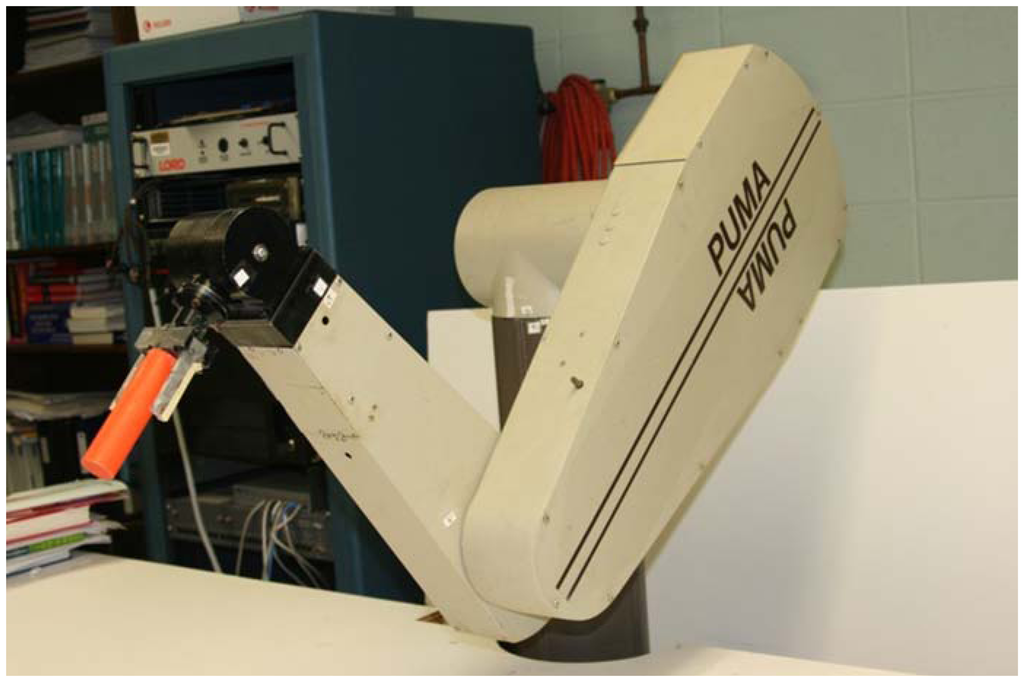A brief history
“Robot,” a word originating from the Czech word “robota,” meaning forced labor, has evolved many definitions over the years. Robots range from small machines that perform menial, repetitive tasks to very intelligent machines that have humanlike characteristics, such as those seen in many pop culture references. Today’s robots, while still unintelligent, have taken on a variety of roles in many fields, including industry, research and medicine.
PUMA 560 Robotic Surgical Arm [3].
There are several robot systems that have been used to perform various surgeries over time. The first documented robot-assisted surgery occurred in 1985. A PUMA 560 robotic surgical arm was used to perform a neurosurgical biopsy. In 1987, the first laparoscopic surgery, in which a fiber optic camera is inserted via an incision in order to observe internal organs, was performed using a robotic system. The PUMA system was used again in 1988 to perform a transurethral resection. The AESOP system developed by Computer Motion was the first to be approved by the FDA for endoscopic surgical procedures. The da Vinci Surgery System became the first FDA approved system for general laparoscopic surgery.
Pros and Cones of using Robots
"+"
- Accuracy
- Repeatability
- May be used in hazardous environment (e.g. radiation therapy)
- May be used to improve specialists’ availability (teleoperation)
- No fatigue
"-"
- Complex machines, and may fail
- Robots are usually stronger than people
- Robots are 'blind'
- Sometimes cumbersome
Interaction Classifications
Surgical robots can be classified into three broad categories on the basis of how the surgeon interacts with them.
- Supervisory controlled systems
The surgeon plans the operation offline and implicitly or explicitly specifies the motions the robot must follow to perform the operation (Fig. 1A). The robot then performs the specified motions autonomously under the supervision of the surgeon. - Telesurgical systems
The surgical manipulator is under direct control of the surgeon with the surgical tools in the form of a robotic manipulator (Fig. 1B). With an on-line input device that is typically a force feedback joystick (master), the surgeon performs the surgical manipulations, and the surgical manipulator (“slave”) faithfully follows the motions of the input device in a master–slave control manner to perform the operation - Shared-control systems
The surgeon and robot share control of the surgical instrument (Fig. 1C) . In these synergistic systems, the surgeon remains in control of the procedure and the robot provides steady-hand manipulation of the instrument.
Figure 1. Interaction classification [1]
The table below shows the robotic devices for neurosurgery that were approved by FDA (some of them a pretty old) :
Examples of state of the art solutions
Robotic patient positioning system
The HexaPOD evo RT System is Elekta’s advanced robotic patient positioning platform providing six degrees of positioning freedom. It is guided by an infrared-camera that enables sub-millimeter patient positioning accuracy in six degrees of freedom – correcting translational errors (x, y, z) and rotational errors (roll, pitch, yaw). [4]
[4]
Da Vinci Robotic Surgery System
Multi-arm robotic system for minimally invasive telesurgery with end effectors controlled via 3D video display and haptic input devices.
Benefit: hand-eye coordination between endoscopy image and instruments less exhausting, since spatial transformation done automatically by system. [8]
ROSA
The Rosa robotic system is the latest generation of neurosurgical computer controlled robots for stereotactic surgery. The Rosa system comprises a mechatronic part consisting of a 6 DoF serial robotic manipulator and a control software part for neurosurgery planning, registration and guidance.
The planning software (Rosana, MedTech) allows for the merging of different and complementary imaging techniques when studying the best surgical approach. The patient initially undergoes an MRI exam (with or without contrast, various supported sequences) to visualize the target anatomical structures, and to plan the optimal guiding trajectory [64], [65]. This plan is then registered to a CT scan, performed nea the time of surgery, and which serves as the reference due to its homogeneous geometric accuracy. An intraoperative Flat-Panel CT can be integrated in the surgery workflow to compensate for brain shift or robot registration errors. After uploading the plan to the Rosa system, the robot is firmly fixed to the skull clamp. The surgery team may choose to register the robot to the intraoperative scene in a frame-basedor frameless approach. The frameless method is carried out using fiducial markers attached to the scalp/skull, or via the Rosa patented automatic surface scan. The latter combines robot motion and laser telemetry to provide a non-invasive registration. The robot is draped after a satisfactory registration and, upon the surgeon’s command, automatically moves to the planned guiding trajectory. It remains in a locked state while the entry point is marked and prepared. Scalp incision and skull drilling is performed with a cordless power drill. The neurosurgeon may choose to insert the probes or electrodes manually through the adapted reducers held by the arm, or may use the haptic robot interface to lower the instruments. [7]
The ROSA robotic arm in the “home” position, after placement of several right temporal depth electrodes during a recent stereoelectroencephalography case. [6]
Bibliography
[1] Nathoo N, Cavusoglu MC, Vogelbaum MA, et al. In touch with robotics: neurosurgery for the future. Neurosurgery. 2005;56:421–433.
[2] Karas CS, Chiocca EA. Neurosurgical robotics: a review of brain and spine applications. Journal of Robotic Surgery. 2007;1(1):39-43.
[3] Lin, H.-I.; Lee, C.S.G. Measurement of the Robot Motor Capability of a Robot MotorSystem: A Fitts's-Law-Inspired Approach. Sensors 2013, 13(7):8412-8430
[5] http://www.renishaw.com/en/neuromate-stereotactic-robot–10712
[6] http://www.neurosurgery.pitt.edu/centers-excellence/epilepsy-and-movement-disorders-program/rosa
[7] Faria, Carlos, et al. "Review of robotic technology for stereotactic neurosurgery." IEEE reviews in biomedical engineering 8 (2015): 125-137.
[8] http://www.tmfhc.org/care-treatment/surgery/da-vinci-robotic-surgical-system/







